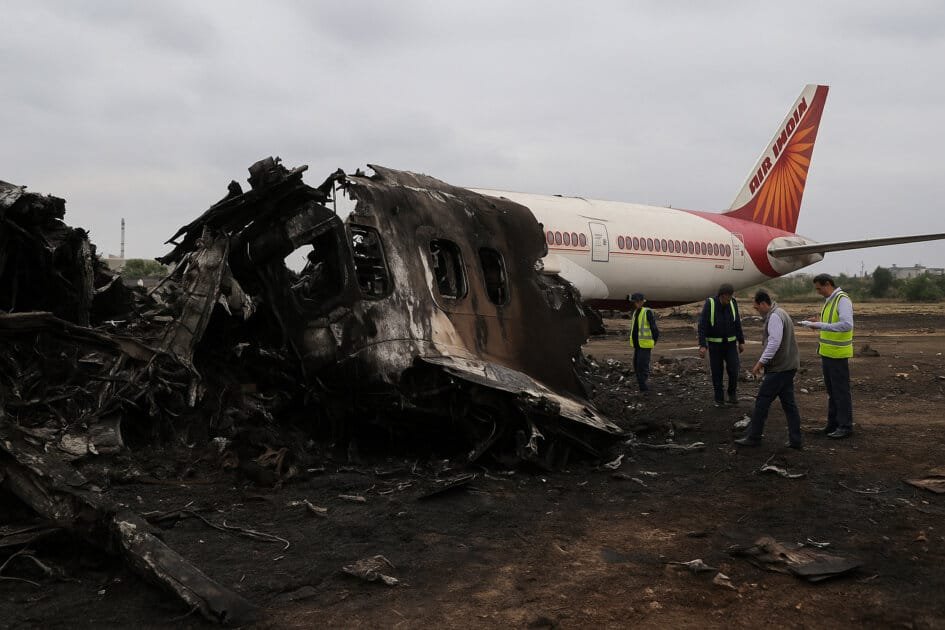Air India Flight 171 Crash, which occurred on June 12, 2025, stands as one of the most devastating aviation disasters in modern Indian history. The Boeing 787-8 Dreamliner, operating a scheduled flight from Ahmedabad to London Heathrow, took off from Sardar Vallabhbhai Patel International Airport at approximately 06:22 AM IST.
Just 30 seconds after takeoff, both engine fuel control switches were moved to the cutoff position, resulting in an immediate loss of thrust. The aircraft crashed into an industrial area near Naroda, killing all 256 people on board and an estimated 18 civilians on the ground—bringing the total confirmed death toll to 274, according to preliminary findings.
The Aircraft Accident Investigation Bureau (AAIB) has confirmed that a manual cutoff of fuel supply to both engines caused the crash. As the nation mourns, families of the victims are demanding justice, accountability, and urgent aviation safety reforms to prevent such tragedies in the future.
Timeline of the Crash
| Time (IST) | Event |
|---|---|
| 06:22 AM | Aircraft receives takeoff clearance |
| 06:23:04 AM | Lift-off initiated from Runway 23 |
| 06:23:07 AM | Both engine fuel control switches move to CUTOFF |
| 06:23:09 AM | Both engines shut down, no thrust |
| 06:23:10–06:23:32 AM | Pilots attempt restart, aircraft begins to descend |
| 06:23:34 AM | Aircraft crashes into an industrial warehouse in Naroda |
| 06:24 AM | Fire and rescue arrive, flames engulf wreckage |

Official Preliminary Report: What We Know
On July 11, 2025, the Aircraft Accident Investigation Bureau (AAIB) released its preliminary crash investigation report, which was independently verified and reported by multiple international media outlets, including:
- The Washington Post
- The Independent (UK)
- CBS News
- Associated Press (AP)
According to the official report:
“Both engine fuel control switches were moved from the ‘RUN’ position to ‘CUTOFF’ within seconds after takeoff. Engine shutdown occurred. A restart was attempted but was unsuccessful due to insufficient time and altitude.”
Fuel Cutoff: Confirmed by AAIB
The fuel control switches, located in the cockpit throttle quadrant, are designed to manually regulate fuel flow to the engines. Moving them to the “CUTOFF” position immediately stops the fuel supply, resulting in an engine shutdown.
The preliminary report confirms the following key points:
- The switches were moved manually, not automatically.
- Their movement resulted in the simultaneous shutdown of both engines.
- Although the pilots returned the switches to the “RUN” position, the engines failed to relight in time.
These switches are equipped with safety latches, which typically require deliberate and intentional action to move. Investigators are now focused on determining how and why both switches were activated during takeoff.
Cockpit Audio: The Voice Recorder Findings
As part of the investigation into the Air India Flight 171 Crash, the Cockpit Voice Recorder (CVR) revealed a chilling exchange moments after takeoff:
Pilot 1: “Why did you cut off the fuel?”
Pilot 2: “I did not.”
This exchange was verified and reported by The Independent (UK) and CBS News. Investigators have not yet identified which pilot made each statement, but the recording adds a critical clue to the mystery surrounding the Air India Flight 171 Crash.
The voice recording reflects a moment of cockpit confusion and alarm, aligning with the broader findings of the preliminary report. No distress signal was sent to Air Traffic Control (ATC). Although one engine relight sequence was initiated, the aircraft involved in the Air India Flight 171 Crash was already too low and slow for recovery.
These findings deepen concerns about flight crew coordination and mechanical safeguards, adding urgency to the calls for reform following the Air India Flight 171 Crash.
Survivors and Casualties
The aircraft was carrying:
- 242 passengers, including 21 Indian students, multiple families, and foreign nationals
- 14 crew members, including Captain J.S. Gill, a senior Boeing 787 commander
- No survivors
An additional 18 to 29 casualties on the ground were confirmed by local police and emergency agencies.

Reaction from Families and Public
Families of victims have expressed grief and anger. Badasab Syed, whose daughter was among the passengers, told The Independent:
“We don’t understand. Was this a mechanical fault or a mistake? Was it avoidable?”
Families are demanding:
- A transparent international inquiry
- Pilot accountability, if confirmed
- Reform of cockpit safety mechanisms
A class action legal group in New Delhi has begun filing RTI requests to access internal DGCA communications.
Air India and Aviation Authorities Respond
Air India has not yet issued a formal apology, but has confirmed full cooperation with:
- India’s AAIB
- United States NTSB
- Boeing (Aircraft Manufacturer)
- GE Aviation (Engine Manufacturer)
The Ministry of Civil Aviation has stated:
“We will leave no question unanswered. Safety reforms will follow after full investigation.”
Past Warnings on Fuel Switch Design
According to an FAA Airworthiness Directive (AD 2018-10-05), Boeing 787s had been flagged for potential uncommanded switch movement due to wiring vibration, though corrective actions were issued globally.
As of now, the AAIB has not confirmed if this crash is linked to that issue. However, Boeing and GE teams have been granted access to the flight control hardware.
Next Steps in the Investigation
The following areas are under continued analysis:
- Flight control unit teardown at Boeing facilities
- Pilot background checks and duty logs
- ATC recordings for procedural review
- Final report expected by mid-to-late 2026
Until then, no further safety recommendations have been formally issued.
Conclusion: A Tragedy That Must Not Be Repeated
The Air India Flight 171 crash is a verified case of complete engine shutdown due to fuel cutoff seconds after takeoff. While how the switches were moved is still under investigation, the consequences are tragically clear.
“This isn’t just an accident. It’s a systemic failure that cost 260 lives.”
— Aviation safety expert, quoted in The Washington Post
As the world watches, victims’ families demand justice. The government and Air India now carry the responsibility not only to investigate, but to ensure such an irreversible loss never happens again.
Verified Sources
- Washington Post – Crash Report
- The Independent – Family Reactions
- CBS News – Fuel Cutoff Verified
- AP News – Aircraft Switch Analysis
- FAA Airworthiness Directive 2018-10-05
DoFollow (AryaLekh)
- Joe Burns Cricketing Renaissance: How He Went from MS Dhoni’s Farewell to Leading Italy into the T20 World Cup
- Operation Sindoor: India’s 23-Minute Strike Hits 9 Terror Camps in Pakistan – No Misses, No Mercy
- Shikshamitra Crisis 2025: Anudeshak Exploitation, Starving Teachers & the Myth of Vishwaguru Bharat
- Health Insurance Claims Portal Oversight: 7 Powerful Truths and Alarming Facts About India’s Reform
- Income Inequality in India: 2024–2025 Humanitarian Decline and National Crisis
- BRICS Expansion 2025: India’s Bold Role in a Changing Global Power Order
- Powerful Surge: Indian Stock Market Today – Nifty & Sensex Climb 215+ Points Amid US Trade Uncertainty
- Breakthrough Startup Surge in India: RBI’s Bold Cybersecurity Overhaul Defines 2025
- Sardaar Ji 3 Controversy: Shocking Cross-Border Casting Ignites Bollywood Firestorm
- Wimbledon 2025 Scandal: Shocking AI Line Call That Changed the Match Forever
- India’s UN Speech on Global South Redefines Global Leadership



